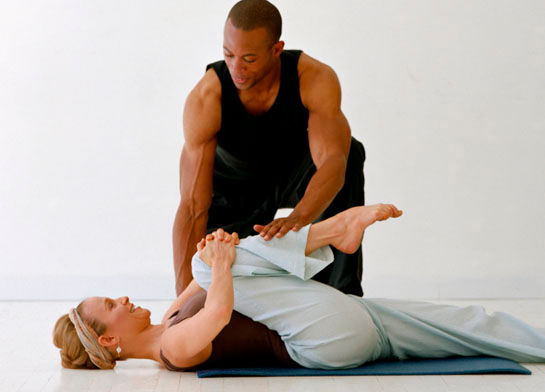
By Megan Senger
Another warm-up spent strolling on the treadmill? Another nose-to-knees runner’s stretch at the end of a workout? If these training techniques seem tired to you (and to your clients!), it may be time to stretch the boundaries of your usual personal-training routines. Why not add variety with a few yoga poses?
JOIN THE CONVERSATION!
Do you use yoga poses with your clients? If so, what are your favorite poses? Share your opinions and experiences in the comments section below.
By including postures from this ancient discipline, personal trainers can do more than just stretch trainees out at the end of a session, says Beth Shaw, the founder and president of YogaFit®, a training school for instructors that specializes in fitness club–friendly yoga. This mind-body specialty emphasizes multijoint exercises and enhances body awareness, functional strength and flexibility, and reduces stress, she says.
Not into yoga? No problem! Here’s how to add some yogic flavor to your exercise selections—it may be easier than you think.
But I’ve Never Done Yoga!
You’ll be pleasantly surprised to learn you already teach some yoga postures, since several closely resemble common gym-based exercises (such as plank pose, for example). What makes them “yogic,” however, is the awareness of mind, body and breath that are brought to the pose, explains Sage Rountree, M.A., Ph.D., a yoga expert, endurance sports coach and author of The Athlete’s Guide to Yoga and The Runner’s Guide to Yoga.
In fact, you don’t have to be a dedicated yoga practitioner to be able to teach basic postures and breathing exercises, says LindaChristy Weiler, M.S., a yoga expert, ACE-certified Fitness Professional, and author of Practical Yoga for Personal Trainers.
Shaw, who is based in Los Angeles, Calif., agrees. Her brainchild YogaFit—which has trained more than 200,000 exercise instructors worldwide and is an ACE educational partner—recently introduced a new “Yoga for Personal Trainers” course. This one-day workshop will be rotated into the YogaFit conferences that are presented monthly in major cities throughout North America, making boning up on some down-dog ideas within easy reach.
To bring more mind-body moves to your clients, try these trainer-friendly selections.
Practical Postures for Trainers
Hold each pose for five to 10 deep breaths (around 20 to 40 seconds) and breathe only through the nose, says Shaw. Repeat as needed and modify for less-fit clients as required.
Doing It Right
To get the most out of these mind-body moves, remember the following:
Keep It Simple (to Start)
As a trainer, you can use yoga postures as your primary training method, or just incorporate them into the beginning and/or end of your clients’ weight-training sessions as a warm-up or cool-down, says Shaw.
However, Weiler encourages trainers to avoid inserting yoga poses between strength-training exercises, because the client’s inner focus might become disjointed. Breaking up poses within the workout “disregards the mind-body value of yoga” she says. Instead, begin with only four or five poses and/or a brief guided relaxation.
Keep It Accessible
Yoga doesn’t have to include the more esoteric aspects of yoga (such as chanting and Sanskrit terms for postures) for your clients to benefit from the physical practice, says Shaw. To this end, YogaFit’s program for personal trainers focuses primarily on asana (poses) and hatha yoga, the branch of yoga that deals with postures and breathing exercises, rather than yogic philosophy and lifestyle.
(Some yoga traditionalists disagree with this approach; this issue was explored in depth in an earlier issue of ACE Certified News.)
Keep It Conservative
Your existing exercise knowledge will be of use when determining which poses to recommend. “For example, some clients need to be pushed and directed to do more or go further in a yoga pose, but the majority will benefit from a softer, gentler approach,” says Weiler.
Moreover, “yoga for athletes isn’t necessarily athletic yoga—the intensity of the yoga must be in inverse proportion to the intensity of an athlete’s training,” says Rountree. Likewise, Shaw believes that deeper stretches should only be introduced at the end of a workout, when the client’s body is fully warmed up.
YogaFit’s Principles of Alignment
Ensure your clients stay well aligned with these YogaFit tips:
Soften and Align the Knees: In all applicable poses, the knees stay in line with the ankles and point directly out over the toes. To prevent hyperextension, keep a microbend in the knees at all times.
Relax Shoulders Back and Down: The shoulders are drawn naturally back and down in poses to help reduce tension in the neck and shoulders.
Hinge at the Hips: When moving into and out of forward bends, hinge from the hips and keep a microbend in the knees.
For detailed descriptions of all seven principles, click here.
Keep It Aligned
Yogafit uses its “Seven Principles of Alignment” (see sidebar) to help create the optimal biomechanical position for clients’ bodies, says Shaw. And the benefits go beyond the gym: “The principles simultaneously provide functional mechanical principles that participants can use in their daily lives.”
Stretching Your Boundaries
“I believe that any personal trainer can and should learn to teach some basic yoga,” says Weiler. “In fact, [because of the benefits of the poses] it would probably be a disservice to your clientele if you did not include yoga techniques in your personal-training repertoire.”
New-to-yoga clients are often surprised to find that the postures don’t have to be excruciatingly hard, says Rountree. And as a trainer, you are uniquely equipped to introduce some yoga flavor to your clients. So if your usual go-to training moves seem tired to you, perhaps it’s time to stretch out.
____________________________________________________________________

Megan Senger is a writer, speaker and fitness sales consultant based in Southern California. Active in the exercise industry since 1995, she holds a bachelor’s degree in kinesiology and English. When not writing on health and lifestyle trends, techniques and business opportunities for leading trade magazines, she can be found in ardha uttanasana becoming reacquainted with her toes. She can be reached at www.megansenger.com.